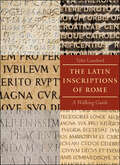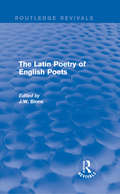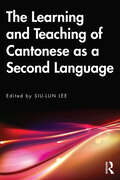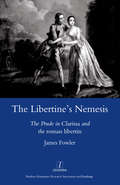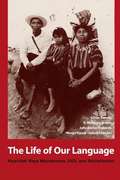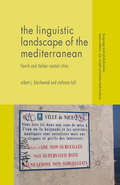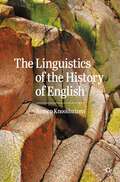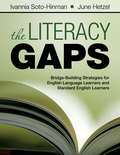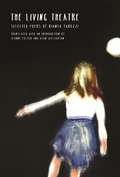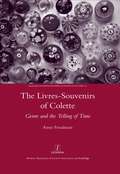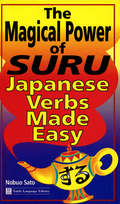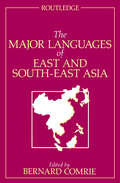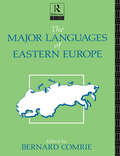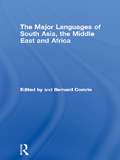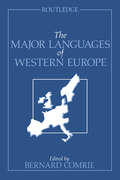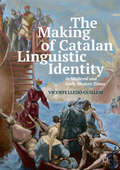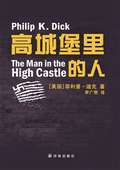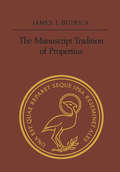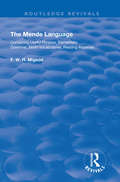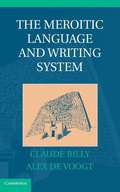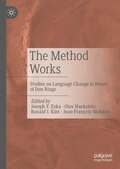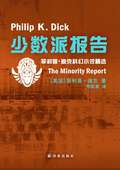- Table View
- List View
The Latin Inscriptions of Rome: A Walking Guide
by Tyler LansfordA collection of 15 guided walking tours of the ancient Latin descriptions found throughout Rome. Rome&’s oldest known Latin inscription dates from the sixth century BC; the most recent major specimen was mounted in 2006—a span of more than two and a half millennia. Remarkably, many of these inscriptions are still to be found in situ, on the walls, gates, temples, obelisks, bridges, fountains, and churches of the city. Classicist Tyler Lansford has collected some 400 of these inscriptions and arranged them—with English translations—into fifteen walking tours that trace the physical and historical contours of the city. Each itinerary is prefaced by an in-depth introduction that provides a survey of the history and topography of the relevant area of the city. The Latin texts appear on the left-hand page with English translations on the right. The original texts are equipped with full linguistic annotation, and the translations are supplemented with historical and cultural notes that explain who mounted them and why. This unique guide will prove a fascinating and illuminating companion for both sophisticated visitors to the Eternal City and armchair travelers seeking a novel perspective into Rome's rich history.&“This book is wonderful. . . . Lansford&’s evocative depictions of monuments, cityscape, and memorable humans have inspired me anew with the fascination of Rome.&” —Mary T. Boatwright, Duke University&“If this book is not slipped into many a Rome-bound suitcase, there is no justice in the world. I can think of few more enjoyable companions on a prowl through the city.&” —Jane Stevenson, Times Literary Supplement (UK)
The Latin Poetry of English Poets (Routledge Revivals)
by J. W. BinnsThomas Campion, Milton, Crashaw, Herbert, Bourne, Walter Savage Landor – all these poets, between them spanning the period from the Elizabethan to the Victorian age, wrote a substantial body of Latin verse in addition to their better-known English poetry, representing part of the vast and almost unexplored body of Neo-Latin literature which appealed to an international reading public throughout Europe. The Latin poetry of these English poets is of particular interest when it is set against the background of their writings in their own tongue: this collection examines the extent to which our judgment of a poet is altered by an awareness of his Latin works. In some we find prefigured themes which were later treated in their English verse; others wrote Latin poetry throughout their lives and give evidence in their Latin poetry of interests which do not find expression in their English compositions. This volume is a valuable resource for students of both Latin and English literature.
The Learning and Teaching of Cantonese as a Second Language
by Siu-Lun LeeThe Learning and Teaching of Cantonese as a Second Language brings together contributions on such issues as Cantonese textbooks, linguistic description, literacy and tone acquisition, supplemented by case studies from the Netherlands and Japan. The learning and teaching of Cantonese as a second language is a subject of considerable interest in the international academic community, and the first international symposium on teaching Cantonese as a second language, held at the Chinese University of Hong Kong in October 2019, brought together leading researchers in this field. This conference provided the inspiration for the current volume, The Learning and Teaching of Cantonese as a Second Language. In the Hong Kong context, historically, the term ‘Cantonese’ refers to the language varieties of immigrants who came to the territory from various areas in Guangdong province, including Macau, Panyu, Taishan, Xinhui and Zhongshan. From the late nineteenth century onwards, their speech coalesced into the contemporary variety of Cantonese used in Hong Kong today. The term ‘Cantonese’ is also used to refer to the entire Yue subgroup of Chinese, which includes varieties of Cantonese spoken in southern China, Hong Kong, Macau, Malaysia, Singapore and among overseas Chinese in Australia, Europe and North America. In all, it is estimated that there are about 70 million Cantonese speakers in the world. This volume is of direct relevance to educators, language teachers, linguists and all those concerned with the learning of Cantonese as a second language.
The Libertine's Nemesis: The Prude in Clarissa and the Roman Libertin
by James FowlerWhat is the role of the prude in the roman libertin? James Fowler argues that in the most famous novels of the genre (by Richardson, Crebillon fils, Laclos and Sade) the prude is not the libertine's victim but an equal and opposite force working against him, and that ultimately she brings retribution for his social, erotic and philosophical presumption. In a word, she is his Nemesis. He is vulnerable to her power because of the ambivalence he feels towards her; she is his ideological enemy, but also his ideal object. Moreover, the libertine succumbs to an involuntary nostalgia for the values of the Seventeenth Century, which the prude continues to embody through the age of Enlightenment. In Crebillon fils and Richardson, the encounter between libertine and prude is played out as a skirmish or duel between two individuals. In Laclos and Sade, the presence of female libertines (the Marquise de Merteuil and Juliette) allows that encounter to be reenacted within a murderous triangle.
The Life of Our Language: Kaqchikel Maya Maintenance, Shift, and Revitalization
by Susan Garzon R. Mckenna BrownThe native Maya peoples of Mexico, Guatemala, Honduras, and Belize have been remarkably successful in maintaining their cultural identity during centuries of contact with and domination by outside groups. <P><P>Yet change is occurring in all Mayan communities as contact with Spanish-speaking Ladino society increases. This book explores change and continuity in one of the most vital areas of Mayan culture--language use. <P> The authors look specifically at Kaqchikel, one of the most commonly spoken Mayan languages. Following an examination of language contact situations among indigenous groups in the Americas, the authors proceed to a historical overview of the use of Kaqchikel in the Guatemalan Highlands. They then present case studies of three highland communities in which the balance is shifting between Kaqchikel and Spanish. Wuqu' Ajpub', a native Kaqchikel speaker, gives a personal account of growing up negotiating between the two languages and the different world views they encode. The authors conclude with a look at the Mayan language revitalization movement and offer a scenario in which Kaqchikel and other Mayan languages can continue to thrive.
The Linguistic Landscape of the Mediterranean: French and Italian Coastal Cities (Language and Globalization)
by Robert J. Blackwood Stefania TufiThis book explores the Linguistic Landscapes of ten French and Italian Mediterranean coastal cities. The authors address the national languages, the regional languages and dialects, migrant languages, and the English language, as they collectively mark the public space.
The Linguistics of the History of English
by Remco KnooihuizenThis textbook approaches the history of English from a theoretical perspective. The book provides a brief chronological overview describing the way in which the English language has changed over time from Old English to Modern English, while subsequent parts adopt a theoretical focus that is thematically organised to deal with the question of how and why English changed in the way it did, including a part addressing some specific contact-induced changes and key topics such as English as a Lingua Franca. Supported throughout with information boxes with empirical studies, the examples given are all drawn from English, but boxes with examples from other languages tie the development of the English language into changes in other contexts and settings. This book is an ideal resource for undergraduate students of the English Language and historical linguistics.
The Literacy Gaps: Bridge-Building Strategies for English Language Learners and Standard English Learners
by Ivannia M. Soto June HetzelBuild bridges of support so English language learners and standard English learners can learn alongside their peers! This comprehensive, research-based guide helps teachers bridge multiple gaps and promote learning for English language learners (ELLs) and standard English learners (SELs). The authors provide strategies, examples, and tools to address: <p><p> The gap between students and texts: covering word recognition, background knowledge, comprehension, and academic language development <p> The gap between students and teachers: including sociocultural differences between teachers and students and teacher perceptions and expectations <p> The gap between students and their peers: discussing language proficiency differences, grouping strategies, and grade-level and schoolwide programs
The Liturgy in Medieval England
by Richard W. PfaffThis is the first comprehensive historical treatment of the Latin liturgy in medieval England. Richard Pfaff constructs a history of the worship carried out in churches - cathedral, monastic, or parish - primarily through the surviving manuscripts of service books, and sets this within the context of the wider political, ecclesiastical, and cultural history of the period. The main focus is on the mass and daily office, treated both chronologically and by type, the liturgies of each religious order and each secular 'use' being studied individually. Furthermore, hagiographical and historiographical themes - respectively, which saints are prominent in a given witness and how the labors of scholars over the last century and a half have both furthered and, in some cases, impeded our understandings - are explored throughout. The book thus provides both a narrative account and a reference tool of permanent value.
The Living Theatre (Lannan Translations Selection Series)
by Bianca TarozziWINNER OF THE 2018 NORTHERN CALIFORNIA BOOK AWARD FOR POETRY TRANSLATION In this first US publication of celebrated Italian poet Bianca Tarozzi, narrative poems (presented bilingually in both English and the original Italian) carry us through the poet's childhood memories of World War II under Mussolini, harsh post-war conditions, and mid-century changes that transformed Italian life, specifically for women. A unique figure in contemporary Italian poetry, Tarozzi draws significant influence from acclaimed American poets-Robert Lowell, Elizabeth Bishop, and James Merrill-interweaving powerful subjects with humor and heart.After:you have packed the suitcase, shut off the gas,turned all the lights out, locked the windowand the big outside door,when you lean against a wall, afraid of falling,and wait, expecting the vehicle,the means that will transport youfar away,when the sky sails clear,blue, and annihilating above the overpass,and you have no past or future,in that empty momentpoetry pitches its tent.Bianca Tarozzi was born in Bologna in 1941. Her father was a political prisoner under Mussolini, and then a Senator after the war. She received a degree from Ca' Foscari University of Venice, and taught English and American Literature for many years at the University of Verona. The recipient of numerous literary honors, she has translated into Italian the works of Elizabeth Bishop, Emily Dickinson, James Merrill, Richard Wilbur, A. E. Housman, Denise Levertov, and Louise Gluck. Also the author of many books of poetry, she began writing poems in 1947, and continues to this day. She currently splits her time between Venice and Milan, Italy.
The Livres-souvenirs of Colette: Genre and the Telling of Time
by Anne FreadmanThroughout her career, Colette experimented with genre for the purposes of telling stories of her life. The books that resulted, known collectively as her 'livres-souvenirs', are far from being autobiographies in the customary sense. By addressing the need to reconsider the generic issues surrounding autobiographical story-telling, Anne Freadman's study brings the richness of 'the genre question' to the fore, shedding a fresh light on this much-loved body of work. From the vignettes ofLa Maison de Claudineto the note-books ofL'etoile vesper andLe Fanal bleu, from stories of losing to stories of collecting, Colette's memory books take different narrative forms and explore the passing of time in different ways. This book investigates Colette's variegated generic choices as so many ways of 'telling time'.
The Magical Power of Suru
by Nobuo SatoThe Magical Power of Suru contains twelve chapters of lively, helpful dialogues, dealing with common activities like shopping, traveling, getting a job, doing business, and visiting a Japanese home. This handy book is the perfect language tool for beginning, intermediate, or advanced students who need to converse in a wide variety of situations quickly and effortlessly.
The Magical Power of Suru
by Nobuo SatoThe Magical Power of Suru contains twelve chapters of lively, helpful dialogues, dealing with common activities like shopping, traveling, getting a job, doing business, and visiting a Japanese home. This handy book is the perfect language tool for beginning, intermediate, or advanced students who need to converse in a wide variety of situations quickly and effortlessly.
The Major Languages of East and South-East Asia
by Bernard ComrieBased on Bernard Comrie's much praised The World's Major Languages, this is a key guide to an important language family. The areas covered include Chinese, Japanese and Sino-Tibetan languages.
The Major Languages of Eastern Europe (The\major Languages Ser.)
by Bernard ComrieFirst published in 2003. Routledge is an imprint of Taylor & Francis, an informa company.
The Major Languages of South Asia, the Middle East and Africa (The\major Languages Ser.)
by Bernard ComrieBased on the much-praised The World's Major Languages, this is the first comprehensive guide in paperback to describe the development, grammar sound and writing system, and sociological factors of the major language families in these areas.
The Major Languages of Western Europe
by Bernard ComrieBased on Bernard Comrie's The World's Major Languages, this is a key guide to one of the major language families. The areas covered include Germanic languages, English, and Romance languages.
The Making of Catalan Linguistic Identity in Medieval and Early Modern Times
by Vicente Lledó-GuillemThe historical relationship between the Catalan and Occitan languages had a definitive impact on the linguistic identity of the powerful Crown of Aragon and the emergent Spanish Empire. Drawing upon a wealth of historical documents, linguistic treatises and literary texts, this book offers fresh insights into the political and cultural forces that shaped national identities in the Iberian Peninsula and, consequently, neighboring areas of the Mediterranean during the Middle Ages and the Early Modern Period. The innovative textual approach taken in these pages exposes the multifaceted ways in which the boundaries between the region’s most prestigious languages were contested, and demonstrates how linguistic identities were linked to ongoing struggles for political power. As the analysis reveals, the ideological construction of Occitan would play a crucial role in the construction of a unified Catalan, and Catalan would, in turn, give rise to a fervent debate around ‘Spanish’ language that has endured through the present day. This book will appeal to students and scholars of historical linguistics, sociolinguistics, Hispanic linguistics, Catalan language and linguistics, anthropological linguistics, Early Modern literature and culture, and the history of the Mediterranean.
The Man in the High Castle (Mandarin Edition)
by Philip K. DickIt's America in 1962. Slavery is legal once again. The few Jews who still survive hide under assumed names. In San Francisco, the I Ching is as common as the Yellow Pages. All because some twenty years earlier the United States lost a war--and is now occupied by Nazi Germany and Japan.小说以 易经 牵引情节 通过对不同阶层,不同身份的人物的穿插描述 讲述了一个反转过来的 历史----同盟国在二战中战败 美国被德国和日本分割霸占 探讨了正义与非正义,文化自卑和身份认同 以及法西斯独裁和种族歧视给人类社会造成的后果 通过对一系列不同人物的塑造 菲利普*迪克讲述了真实和虚幻的生活及历史
The Manuscript Tradition of Propertius
by The Estate of James ButricaThe elegist Sextus Propertius (ca 50-ca 16 BC) is generally reckoned among the most difficult of Latin authors. At the root of this difficulty lies a deeply corrupt text and uncertainty over the manuscript transmission; moreover, the manuscripts used in the standard editions of today have been selected without a comprehensive examination of the surviving copies. This study, the fullest survey of the manuscripts so far, considers the affiliation of more than 140 complete or partial witnesses and offers a thorough reassessment of the tradition. The principal novelty is the argument that six Renaissance copies represent an independent third witness to the archetype, revealing passages where corruptions, glosses, or medieval corrections are now accepted as the words of Propertius and suggesting that the archetype was far more corrupt than now commonly supposed. The study is in two parts. In Part One, after a survey of Propertius' fortuna in the Middle Ages, the author considers the affiliation and history of the known manuscripts and editions to 1502, then offers a text and revised apparatus of four elegies; in Part Two he presents detailed descriptions of 143 manuscripts, most of them from personal inspection.
The Meaning of Tingo
by Adam Jacot de BoinodDid you know that people in Indonesia have a word that means 'to take off your clothes in order to dance'? Or how many words the Albanians have for eyebrows and moustaches? Or that the Dutch word for skimming stones is plimpplamppletteren? Drawing on the collective wisdom of over 154 languages, this intriguing book is arranged by theme so you can compare attitudes all over the world to such subjects as food, the human body and the battle of the sexes. Here you can find not only those words for which there is no direct counterpart in English (such as the Japanese age-otori which means looking less attractive after a haircut), but also a frank discussion of exactly how many 'Eskimo' terms there are for snow, and a vast array of information exploring the wonderful and often downright strange world of words. Oh, and tingo means 'to take all the objects one desires from the house of a friend, one at a time, by asking to borrow them'.
The Mende Language: Containing Useful Phrases, Elementary Grammar, Short Vocabularies, Reading Materials (Routledge Revivals)
by F.W.H. MigeodFirst published in 1908, this volume emerged in the midst of the British Protectorate of Sierra Leone. The author, F.W.H. Migeod, studied the Mende nation in eastern Sierra Leone and followed the example of the grammar (1882) and vocabulary (1884) published by Dr. Schoen in using the southern form of the Mende language. Beginning with an introduction to the recent history, culture and characteristics of the Mende nation and Sierra Leone, this volume covers useful phrases, grammar, vocabulary and example reading materials including stories and songs collected from native speakers.
The Meroitic Language and Writing System
by Claude Rilly Alex De VoogtThis book provides an introduction to the Meroitic language and writing system, which was used between circa 300 BC and 400 AD in the kingdom of Meroe, located in what is now Sudan and Egyptian Nubia. This book details advances in the understanding of Meroitic, a language that until recently was considered untranslatable. In addition to providing a full history of the script and an analysis of the phonology, grammar and linguistic affiliation of the language it features: linguistic analyses for those working on Nilo-Saharan comparative linguistics, paleographic tables useful to archaeologists for dating purposes and an overview of texts that can be translated or understood by way of analogy for those working on Nubian religion, history and archaeology.
The Method Works: Studies on Language Change in Honor of Don Ringe
by Joseph F. Eska Jean-François Mondon Olav Hackstein Ronald I. KimThis volume contains an introductory essay, the bibliography of Professor Ringe, and nineteen articles on various aspects of historical linguistics composed by current and former colleagues and students at the University of Pennsylvania and a select number of leading scholars in the field based at institutions such as Cornell University, Harvard University, Oxford University, Saarland University, University of Georgia, University of California at Los Angeles, University of Munich, and York University. The majority of contributions focus upon linguistic phylogenetics (the interrelationships among languages), Classical linguistics, and Germanic linguistics. Many of the contributions make contributions to theoretical, as well as historical, linguistics.
The Minority Report (Mandarin Edition)
by Philip K. DickPolice Commissioner John Anderton finds himself at the mercy of his own crime-prevention system when the prescient precogs he's hired to stop crime before it starts peg him as a soon-to-be murderer in Philip K. Dick's masterful short story The Minority Report. This slim volume is top-bound like an office account and perfectly timed, the movie version, directed by Steven Spielberg and starring Tom Cruise, is due out this summer but whether fans will shell out the dough for a single short story that's available in various collections remains to be seen. 本书结集科幻鬼才菲利普*迪克最具代表性的九个短篇 第二代 , 冒名顶替 , 规划小组 , 少数派报告 , 战争游戏 , 啊 当个布洛贝尔人 , 死者的话 , 全面回忆 和 电子蚂蚁 菲利普*迪克以其独特的文风和光怪陆离的想象在美国科幻黄金时代独树一帜 他的短篇小说情节跌宕 很多故事的架构都勘称一绝 菲利普*迪克的小说主人公往往是困在极不寻常情镜中的小人物 他们被自己扭曲的感知误导 进退维谷 找不到出路
